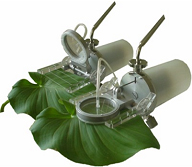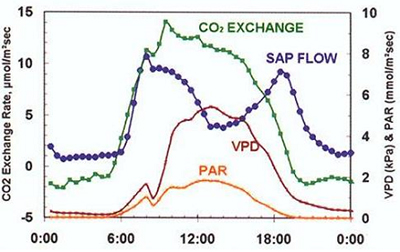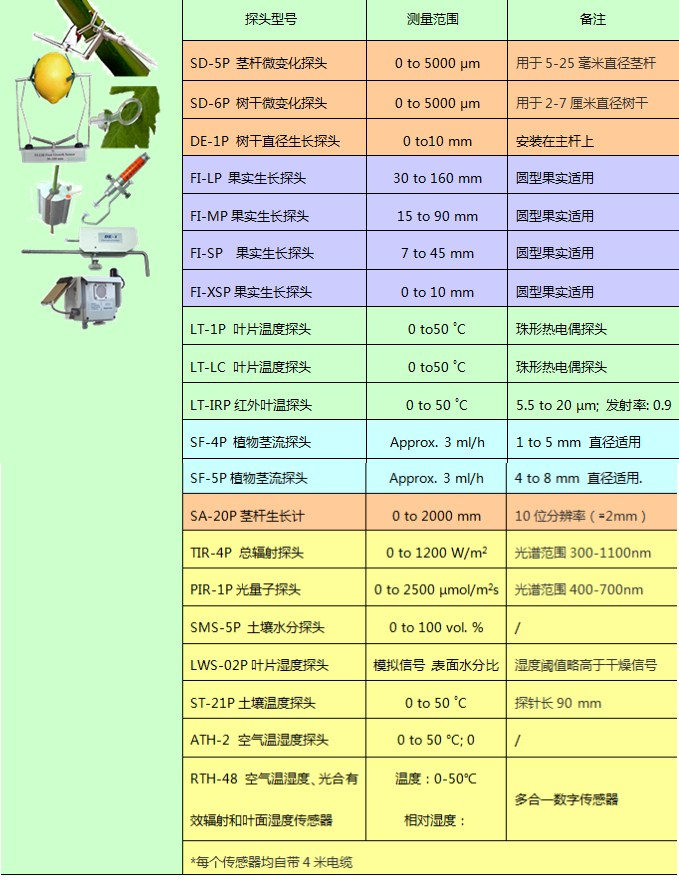| It can realize the synchronous continuous monitoring of plant photosynthetic rates, physiological indicators and environmental factors |
|
The PTM-48A is a photosynthesiser, but it is not an ordinary photosynthesiser.It is designed for long-term continuous monitoring and can be monitored for up to several weeks.The special automatic open-closing leaf chamber can minimize the impact of leaf chamber closing on leaf growth.The design of 4 leaf chamber channels allows researchers to monitor multiple plants or leaves simultaneously. The PTM-48A is a photosynthesiser, but it is more than just a photosynthesiser.It is also a multi-channel plant physiological and environmental monitoring system.It can connect up to 8 sensor channels to achieve synchronization of environmental factors (PAR, air temperature and humidity, soil temperature and humidity, etc.) and plant physiological indicators (leaf temperature, stem flow rate, slight changes in stems, fruit growth, etc.)monitor. | |
Main functions | |
Can monitor blades CO continuously for 24h2Gas exchange · Get daily CO2Net assimilation (net production) · Analyze CO during the day and at night2Exchange equilibrium (photosynthesis and breathing) · Research on light, temperature, and CO in detail2Effects of concentration and other environmental factors on yield Can monitor blades continuously for 24h2O Gas exchange, transpiration rate and pore conductivity Continuous monitoring time can last for hours, days or even weeks With 4 leaf chambers, multiple plants or leaves can be monitored simultaneously The LC-4B leaf chamber can be carefully studied through the latest LC-4D shaded leaf chamber2Exchange response to light |
LC-4B Leaf Room |
Through external sensors, many environmental and physiological indicators such as stem flow, slight changes in stem fruits, air temperature and humidity, and PAR can be synchronized. | |
Application areas |
LC-4D Shading Leaf Room |
· Optimize cultivation methods to achieve high yields · Find the limiting factors for increased yield.To take appropriate measures at the right time, continuous monitoring is required · Find out the limiting factors of the plant itself—such as the stomatal factor · Comparison of the differences between different types and treatments · Applicable to broad-leaf research | |
· It can be widely used in many fields such as plant physiology, ecology, agriculture, horticulture, crop cultivation, facility agriculture, water-saving agriculture, etc. In Europe, some experts use it as a long-term monitoring system for the ecological environment, examining the changes in plant environmental conditions along the Mediterranean coast and CO2The exchange process In South Korea and Japan, Asia, users use the system to monitor crops in growth chambers for long-term monitoring. | |
Measurement parameters | |
Photosynthetic gas exchange measurement value: CO2Assimilation rate, transpiration rate, pore conductivity, reference and leaf chamber CO2Concentration, reference and leaf chamber H2O concentration, leaf chamber air flow, water vapor pressure saturation loss, atmospheric pressure, etc. Measured values of external sensors: plant stem flow, slight changes in stems, trunk diameter growth, fruit growth, leaf surface temperature, PAR, air temperature and humidity, soil temperature and humidity, etc. | |
Main technical parameters | |
· Input number of leaf chambers: 4 · Leaf chamber area (optional): LC-4B standard 20 cm2;LC-4W narrow leaf 10 cm2 · Standard length of the connecting pipe: 4 m · Indoor air flow rate of leaves: 0.9 ± 0.1 LPM · co2Concentration measurement range: 0-1000 ppm · co2Gas exchange measurement range: -40 to 40 µmol CO2without-2yes-1 · H2O Gas exchange measurement range: 0 to 50 mg H2O No-2yes-1 · Number of digital sensor input channels: 1 PAR, air temperature, air humidity and blade humidity 4 in 1 sensor Can be attached: Soil temperature, moisture content and conductivity 3 in 1 sensor · Number of analog sensor input channels: 8 · Analog signal input range: from 0-1 Vdc to 0-10 Vdc programmable · Power supply method (optional): 100-240 VAC AC, 12 V rechargeable battery, solar panel · Connect to serial port (optional): USB and GPRS wireless transmission |
LC-4W leaf chamber |
Application examples | |
The following figure is the monitoring results of cotton leaves for one day. This is just a numerical comparison of some sensors. The system can obtain numerical comparison graphics of multiple sensors, making the test results clearer on the figure, which will study the impact of environmental factor changes on plants.More convenient. | |
| |
PTM-48A Optional Sensor Probe | |
| |
Origin: Israel BF-Agritech | |
References | |
Ben-Asher J. 2006 Net CO2 Uptake Rates for Wheat Under Saline Field Conditions: a Novel Method for Analyzing Temperature Effects on Irrigation Management., The annual meeting of the Amer. Soc. Agron.Indianapolis November 2006 p. 229-4 Ben-Asher J., P.S. Nobel, E. Yossov and Y. Mizrahi 2006 Net CO2 uptake rates for Hylocereus undatus and Selenicereus megalanthus under field conditions: Drought influence and a novel method for analyzetemperature dependence. Photosynthetica 44:181-186 Ben –Asher. J. A. Garcia S. Thain and G. Hoogenboom2007 Effect of temperature on Photosynthesis and transspiration of corn in a growth chamber. The annual meeting of the Amer. Soc. Agron. New OrleansNovember 2007. P.321-2 Evrendilek F., J Ben-Asher, Mehmet Aydin and Ismail Celik 2004 Spatial and temporal variations in diurnalCO2 fluxes of different Mediterranean ecosystems in Turkey Proceeding of the RIHN Kyoto Japan 2004 Jiftah Ben-AsheLucas Menzel Pinhas Alpert Fatih Evrendilek and Mehmet Aydin 2004 Climate change in the eastern Mediterranean and agriculture ICCAP annual meeting. Turkey Fatih Evrendilek, Jiftah Ben-Asher, Mehmet Aydin and Ismail Celik 2005 Tomohisa YANO1, Mehmet AYDIN2, Hiroshi NAKAGAWA3, Mustafa ÜNLÜ4, Tohru KOBATA5, Celaleddin BARUTÇULAR4, Tomokazu HARAGUCHI6, Müjde KOÇ4, Masumi KORIYAMA6, FatihEVRENDİLEK2, Jiftah BEN-ASHER7, D. Levent KOÇ4, Kenji TANAKA8, Rıza KANBER4 2007 Implicationsof Future Climate Change forCrop Productivity in Seyhan River Basin. Joint Reprot ICCAP RIHN KyotoJapan Jiftah Ben –Ashera* Axel Garcia y Garciab and Gerrit Hoogenboomb 2008 Effect of High Temperature onPhotosynthesis and Transpiration of Sweet Corn (Zea mays L. var. rugosa). Photosynthetica Submitted J. Ben-Ashera , Y. Mizrahia and P.S. Nobelb 2008Transpiration, stem conductance, and CO2 exchange of Hylocereus undatus (a pitahaya) Acta Hort, ISHS (in press) J. BEN-ASHER 2005 Net CO2 uptake rates for wheat (Triticum aestivum L.)under Cukurova field conditions:Salinity influence and a novel method for analyzing effect of global warming on agricultural productivity. Areport submitted to the ICCAP project. RIHN Kyoto Japan.201-204 | |





